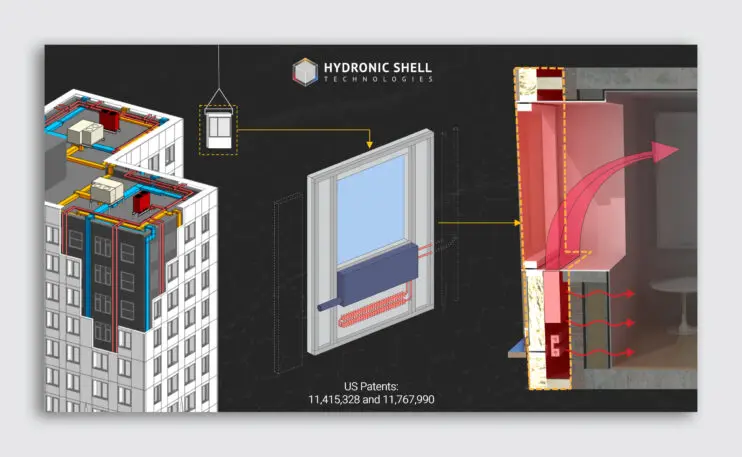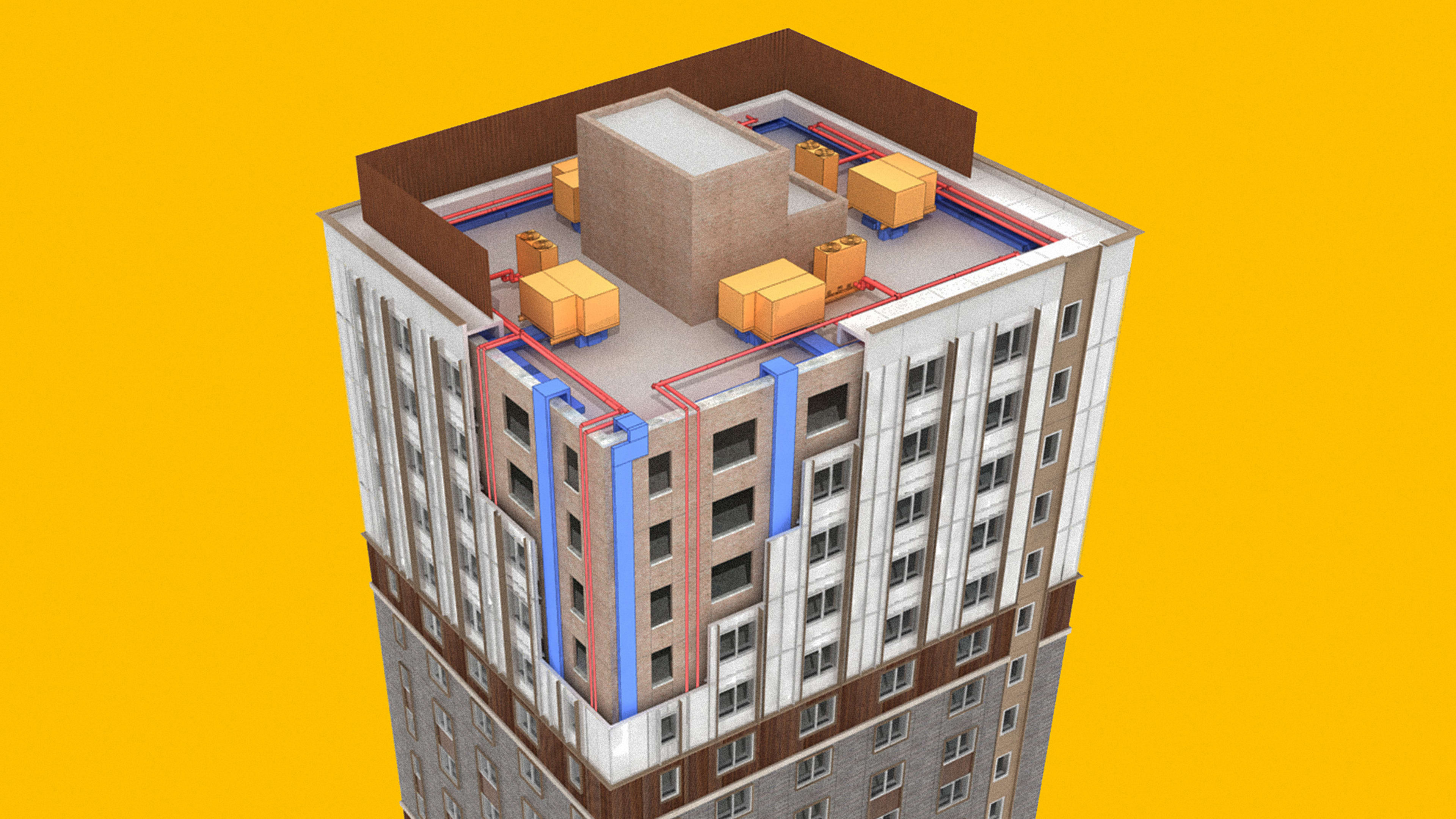The carbon footprint of new buildings keeps shrinking. But most buildings are old—and heating and cooling them is one of the world’s largest sources of emissions. It isn’t a simple process to retrofit a large building to make it more efficient and get rid of fossil-fueled heat. But one new startup wants to make retrofits easier and cheaper by baking all the changes into a new facade.
The startup, called Hydronic Shell Technologies, designs prefab panels with built-in insulation, heating, cooling, and ventilation aimed at retrofitting old apartment buildings. Because the panels are attached outside, tenants don’t have to move out when the retrofit happens.
Founder David Goldstein started thinking about the idea after New York City passed a law in 2019 requiring large buildings to cut energy use. Goldstein, an engineer, had worked on a project to help a multifamily building decarbonize.

“It really opened my eyes to two huge challenges,” he says. “One was just the economics. To do this kind of retrofit work and get any kind of return on investment was extremely difficult; these projects just didn’t pencil out.” The second problem was the logistical challenge of trying to retrofit a building with people living inside.
Goldstein knew that it was possible to add insulation via a new facade—like wrapping the building in a blanket—and started thinking about how the “blanket” could also be heated. Because most old buildings don’t have insulation in their existing walls, if the facade were heated, the warmth would travel inside.

The new design uses hot water running through pipes in the facade for heating, and cool water for cooling. It also replaces old windows with new ones and has built-in ventilation, helping improve air quality in old buildings that typically don’t have full HVAC systems. (This can improve tenants’ health in multiple ways, from eliminating mold in apartments to filtering out wildfire smoke from outdoor air.) All the components are easily accessible in supply chains.
“It’s actually not that complicated,” Goldstein says. “It’s using equipment, pipes, construction methods that all already exist today. It’s just putting them together in a different way.”
In an inefficient building with no insulation, not to mention leaky windows that let in cold air, the retrofit has the potential to cut energy use by more than 90%. That’s because of the new extra-insulated shell and because the pipes can be connected to an efficient heat pump. (The design can also work with other types of technology, including geothermal systems that capture heat from underground.)

The aim is for Hydronic Shell to eventually work with financing partners who will give building owners construction loans that can easily be repaid because of the savings on energy bills. “The operational savings that you get can exceed your loan payment,” Goldstein says. “If you can achieve that, and the building owner essentially has no money out of pocket, then they’re cash-flow positive from day one.”
Early next year, the startup will begin prepping a site for its first pilot project, a seven-story low-income apartment building in Syracuse, New York, run by the city’s public housing agency. Some of the funding will come from the Housing Affordability Breakthrough Challenge, a competition run by Enterprise Community Partners and Wells Fargo that recently selected the project as one of six winners.
“If we can create healthy, climate-ready homes for families with lower incomes, we can do it for everyone,” says Jacqueline Waggoner, president of the solutions division at Enterprise Community Partners. “Hydronic Shell’s innovation has the potential to change how we make communities greener nationwide.”
BlocPower, another startup that works to make old buildings more sustainable, is partnering on the project, helping manage construction and community engagement. (In the future, BlocPower may be one of several partners implementing the technology as a turnkey solution).
The community will help shape the appearance of the facade. “We want to make sure we’re giving people in the community what they want,” Goldstein says. “There’s going to be a whole process of presenting design options and letting them steer the direction that things go as far as the aesthetics of the building. Because at the end of the day, the technology works the way it works, but the appearance of the building can literally be anything.”
The process starts by using a drone to fly around the building and take a 3D scan of the shape. That data then goes into a computer model that can be used to lay out the design of the facade and Hydronic Shell’s system. Although the dimensions of each building will be slightly different, the company will aim to streamline the production process as much as possible. A crane will likely be able to install between 6 and 10 panels per day, amounting to roughly the size of a single apartment.
Still, scaling up is daunting. “The numbers are so big that it’s almost impossible to comprehend,” Goldstein says. “I’m in New York City, and if we look at it as an example, it has about 1 million buildings. Most of them have to be retrofitted in the next 25 years if we want to be net zero by 2050. The thought of retrofitting almost this entire city in 25 years is just truly mind-boggling, and I don’t think people really appreciate how big this challenge actually is.”
Recognize your brand’s excellence by applying to this year’s Brands That Matter Awards before the final deadline, June 7.
Sign up for Brands That Matter notifications here.
